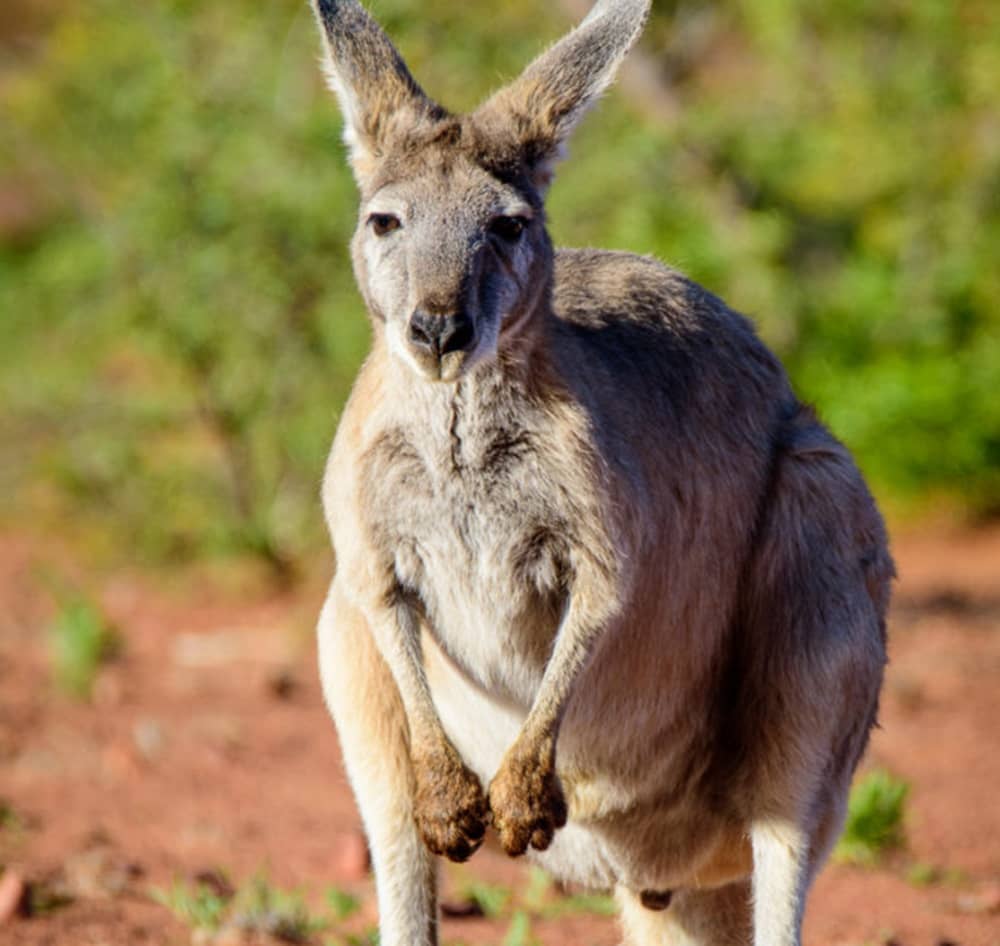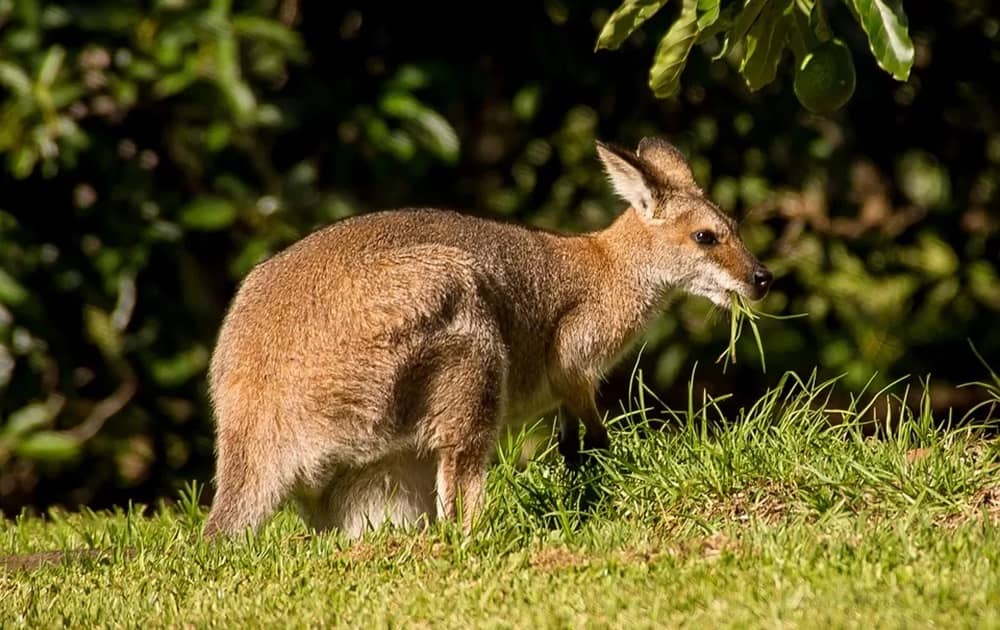Wallaroo is a name that comes from two species, “Kangaroos” and “Wallaby.” The most common species of Wallaroo is the common Wallaroo. There are other species of wallaroos; the common wallaroo is one of them, i.e., Gray Wallaroo, Red Wallaroo, Black Wallaroo, and Antilopine Wallaroo. They are native to rocky and arid regions of Australia and inhabit scrublands and forests. They are known for their adaptability and robust physicality.

Wallaroos belong to the macropod family, closely related to kangaroos and wallabies. Wallaroos have muscular, stocky bodies. They have short limbs and a distinctive long tail that helps them balance. Their fur can vary from dark gray to reddish brown; depending on the species or geographic location.
Macropus robustus is the scientific name of the common Wallaroo. They can adapt themselves easily to harsh environmental conditions. They are very rare marsupials in the United States, as some states have banned their ownership. These animals have thick fur and strong limbs, which help them navigate rugged terrain.
Size Information
Wallaroos are larger than wallabies but smaller than kangaroos. They are of medium size up to 3 to 5 feet and weigh 40-80 pounds.
Lifespan
Wallaroos have a lifespan of about 15 to 20 years in captivity, with proper care and a healthy environment.
Male Vs Female Wallaroo
Male Wallaroos are much larger and more territorial than female Wallaroos. Males are typically more dominant and have aggressive behavior, especially during mating seasons. So, to handle male Wallaroos, you need to be experienced. However, females are more docile and social with humans and other animals in captivity.
Behavior and Temperament of Wallaroo
Wallaroos are shy animals, and they take time to interact with humans and other animals. Male Wallaroos are solitary animals, but when they are comfortable, they can bond nicely. Wallaroos are very curious marsupials; slowly and with patience, they become social animals. But sometimes, because of their aggressive behavior, they can be destructive. So you need to supervise them. They are very active so they can break furniture or things at your home and dig holes when they are getting bored. So you need to keep them busy with some exercise or activities.
They need to be handled with respect and patience. With time, they can become more comfortable and socialize with humans. They require a lot of space to hump, hop, and explore. They can socialize with other animals like dogs, except cats, which can be harmful for them. Just give them some time to adjust; when they feel comfortable and adjustable, they will bond with other animals.
How to Take Care of Wallaroos?
To take care of your pet Wallroos, you need to be careful and understanding of their needs. You need to be fully aware of their balanced diet and in what space or enclosure is best for them.
What do Wallaroos Eat and Drink?
Wallaroos are herbivorous, meaning they feed on grasses, leaves, and shrubs in the wild. But in captivity, you can provide them some fresh hay of high quality, such as timothy hay, which is rich in fiber, which aids digestion, or alfalfa, which is higher in protein and calcium. Also, you can provide fresh grasses to them to mimic their natural behavior. Wallaroos can also consume vegetables, so you can treat them with some fresh vegetables like broccoli, carrots, or sweet potatoes.

A commercial diet of kangaroo or wallaby can also be given to them. These diets are easily available in exotic pet stores. You need to keep them healthy with a balanced diet. Give them a large portion of untreated grass. Also, you need to give them fresh water access all the time.
For a baby wallaroo, you can give a specialized formula like Biolac or Wombaroo diet.
Foods to Avoid
- Processed human foods like bread or pasta.
- Sugary snacks.
- Dairy products like chocolates.
- Caffeine
- Onions and garlic
Wallaroo Enclosure
Wallaroos are Australian animals; they inhabit forests in the wild. So they need a large space to hop, jump, and explore. If you do not have that much space, Wallaroo is not the right pet for you. The enclosure for pet wallaroos should be spacious, secure, and escape-proof. A minimum of 1500-2000 square feet is ideal for one wallaroo. Fencing should be at least 6-8 feet high to prevent them from hopping out. You can use strong wire mesh or chain-link for fencing. The gaps in the fence should be small enough to prevent them from getting caught or injured.
You should provide them with a shaded area or a shelter to prevent them from harsh weather conditions like rain or cold temperatures. A soft bed with hay or straw with access to fresh, clean water are one of the prime requirements of its enclosure. You need to clean the enclosure regularly to maintain a healthy environment.
Specific Substrate Needs
You can add some rocks and logs into the enclosure to stimulate their natural rocky terrain and climb on them. Provide your pet wallaroo with some interactive toys, such as large balls or hanging ropes, which keep them engaged and get rid of boredom. You can scatter some foods in surrounding areas to encourage natural foraging behavior.
How to Handle a Pet Wallaroo?
To handle a pet wallaroo, you need to be very cautious and experienced. They are not easily comfortable with humans; they need time to adapt themselves to the new environment and new people. Always approach them calmly and avoid sudden movements that can frighten them. You should always try to allow them to come to you and avoid any forceful interactions. If you are handling a newborn wallaroo, please be careful with them. You can use a simulated pouch to carry them, which will give warmth and security to them. They are very active and powerful animals, so if you handle them roughly, it may lead to injuries to you and your pet.
Exercise
Exercise is very crucial for Wallaros to maintain their physical health and prevent them from health issues. They are very active and playful animals that get bored easily if they are not getting engaged with anything else. So, you need to keep them engaged in some activities and exercises. You can arrange some platforms, logs, or rocks to engage them with their natural activities like jumping, climbing, hopping, etc. You can do interactive feeding to stimulate their mental health, like using food puzzles or hanging treat dispensers that make your wallaroo stretch and get the food.
Also, you can let your wallaroo hop and roan in a safe yard with your supervision. Wallaroos are crepuscular, meaning they are most active during the early morning and late afternoon or evening. So, encourage them to exercise during these times. If you have more than one wallaroo, give them time with each other to become socialized.
Health Issues with Wallaroo
Some major health issues can occur to your wallaroos if they are not getting proper and balanced diet and exercise. Metabolic Bone disease (MBD) is caused by a deficiency of calcium or vitamin D. Weakness, brittle bones, and swollen joints can be the symptoms of this. So you ensure to give a balanced diet with enough calcium and avoid foods that are high in phosphorus. Also, give them natural sunlight to get Vitamin D.
Obesity is also a major issue among Wallaroos in captivity. If they are overfed and not provided enough exercise after feeding, this may lead to difficulty hopping, lethargy, and increased body fat. Daily exercise is mandatory to maintain a healthy weight.
Bloating is caused by sudden changes in diet or consuming foods that ferment quickly in the gut, like grains or high-sugar fruits. You need to maintain a consistent, grass-based diet, and if you are introducing new foods, give them gradually.
Diarrhea can result from a poor diet or stress. Loose or watery stools can be the symptoms of this. You should provide a diet rich in fiber and keep stress levels low by maintaining a calm and friendly environment.
Wallaroos can have respiratory infections, especially if they are kept in damp or poorly ventilated conditions. Coughing, nasal discharge, difficulty breathing, and lethargy can be the symptoms. You should ensure that their enclosure is clean and well-ventilated. Do not take them in extreme cold and wet weather.
Both internal and external parasites can affect Wallaroos, especially in outdoor enclosures. Worms like tapeworms, roundworms, and coccidia can cause gastrointestinal issues. Mites, fleas, and ticks can also plague wallaroos. Itching, hair loss, skin irritation, weight loss, or diarrhea can occur because of this.
Veterinary Treatment
If your pet Wallaroo is facing any of these health issues, they need an immediate checkup from the vet. Veterinary treatment for Wallaroos should be taken from an exotic animal vet who is experienced with these marsupials. You should ensure regular health checkups, vaccinations, and parasite control of your pet to maintain their physical and mental health.
Grooming
Wallaroos need very low maintenance. They groom themselves, but you need to take care of their environment. Their surroundings should be clean and free from debris that could stick to their fur. They need regular checkups for ticks or parasites with the vet to ensure a healthy. They don’t require much grooming.
Can you Own a Pet Wallaroo?
Ethics
Wallaroos are wild animals. Owning them as a pet is a big responsibility for the owners. As they need large space to roam and explore, your house should be as big according to their requirements. As sometimes they are moody creatures, they can create a mess in your house because of their active and curious behavior. Before purchasing a pet, you need to ensure that you are taking them from a reputable breeder and not from the wild.
Legality
You can own a pet wallaroo but it depends on some specific locations. Some of the states in the US do not allow to keep them as pets due to their safety, or you need some special permits to have one. Many countries and states have strict regulations on keeping these exotic animals. You need to always check your local laws before acquiring one, as it can be illegal in some countries or states.
Where to Buy
If you have decided to own a wallaroo, you need to ensure that you are buying from a reputable breeder or licensed exotic pet facility. Never purchase Wallaroos from illegal traders because it is an unethical practice. Always look for those breeders who specialize in macropods and have experience raising them in captivity. Some exotic pet stores may also offer wallaroos, but ensure that they are following proper animal welfare laws.
Upkeep Cost
The purchasing cost of a wallaroo can be up to $1000-$4000 with some other housing needs. Also, you need to invest in the diet of your wallaroo, which can cost about $200-$400 monthly.
Reproduction and Breeding of Wallaroo
In captivity, breeding wallaroos need specialized care. They mate during the wet season mostly. They can breed all year round but do not breed in dry seasons. Females give birth to babies after a short gestation period of about 30 days. The baby wallaroo is known as ‘Joeys.’ The newborn Joey climbs into the mother’s pouch, where it continues to develop for several months.

After leaving the pouch, the joey remains dependent on the mother for another 6 months. Joeys leave the pouch permanently at around 10 to 12 months of age but need nursing. Male Wallaroos become sexually mature at around 18 to 24 months of age. Females reach sexual maturity earlier, at around 14 to 24 months.
Delayed Implantation
One of the most interesting aspects of Wallaroo reproduction is their ability to delay embryo development through a process called embryonic diapause. If a female already has a joey in her pouch, she can pause the development of the new embryo until the current joey is ready to wean.
Related Species
Some of the related species to common wallaroos are:
- Wallaby (Notamacropus rufogriseus)
- Eastern Grey Kangaroo (Macropus giganteus)
- Capybara (Hydrochoerus hydrochaeris)
- Patagonian Mara (Dolichotis patagonum)
Pros and Cons of Owning a Pet Wallaroo
Pros
- Wallaroos are rare and unique pets, which makes them uncommon from other animals.
- Wallaroos can form strong bonds with their owners and become affectionate companions.
- Female wallaroos can delay their implantation if females have already a joey in their pouch.
- Wallaroos are very low-maintenance pets, as they groom themselves.
- Wallaroos have fascinating behaviors such as hopping, foraging, and using their forelimbs to communicate.
- Wallaroos are herbivores; they eat grasses, which are easy to provide and low cost.
- Wallaroos are generally low-noise pets; they do not make unnecessary sounds.
Cons
- Wallaroos need a large enclosure with enough space to hop and roam freely, which can be difficult for owners.
- Wallaroos are not domesticated like dogs or cats and may not be as easy to train or handle.
- During mating season or when threatened, male Wallaroos can become aggressive and may use their powerful hind legs to kick.
- Finding a veterinarian with experience in treating wallaroos can be challenging and expensive.
- Owning a Wallaroo may be illegal or require special permits in certain regions due to wildlife protection laws.
- Wallaroos can sometimes chew on furniture, plants, and other objects, causing damage if not supervised properly.
Some Interesting Facts about Wallaroo
- The word wallaroo comes from two words: kangaroo and wallaby.
- Wallaroos are smaller than kangaroos but larger than wallabies.
- Wallaroos can leap up to 6 feet high in a single bound.
- Wallaroos are well-suited to rocky, hilly environments.
- Wallaroos use their strong, muscular tails for balance when hopping and as a support when sitting or resting.
- Wallaroos can live up to 20 years in captivity, making them one of the longer-living marsupial species.
- Female wallaroos can undergo a reproductive process called delayed implantation. After mating, the fertilized egg may not immediately implant in the uterus. This allows the female to time the birth of the joey with favorable environmental conditions. The development of a new embryo can be delayed until the previous Joey has left the pouch.
- Wallaroos communicate by thumping their hind legs on the ground.
- Wallaroos are picky eaters.
Frequently Asked Questions
Question 1: Can wallaroos be kept as pets?
Answer: Yes, wallaroos can be kept as pets, but they require special care and attention, along with sufficient space, a proper diet, and a large enclosure. It’s important to check local laws, as owning a wallaroo may be restricted or require permits in some regions.
Question 2: What do wallaroos eat?
Answer: Wallaroos are herbivores and primarily eat grasses, leaves, and shrubs. In captivity, their diet should include fresh grass, hay, specialized pellets, and occasional vegetables.
Question 3: Do wallaroos need companionship?
Answer: Wallaroos are generally solitary in the wild, but in captivity, they can benefit from social interaction, either with humans or other compatible animals like wallabies or other wallaroos.
Question 4: How long do wallaroos live?
Answer: In captivity, wallaroos can live up to 20 years with proper care, while in the wild, their lifespan tends to be around 12-15 years due to environmental challenges.
Question 5: Are wallaroos aggressive?
Answer: Wallaroos can show signs of aggression, especially during the mating season or if they feel threatened. Males, in particular, may become territorial and can deliver strong kicks with their hind legs.
Question 6: Can wallaroos be trained?
Answer: Yes, wallaroos need regular veterinary check-ups, preferably from an exotic animal specialist. Vaccinations, parasite control, and general health monitoring are essential to their well-being.
Question 7: Where can I buy a wallaroo?
Answer:You can buy wallaroos from specialized breeders of exotic pets. It’s essential to research and buy from a reputable breeder, ensuring that the animal is ethically sourced and legal in your area.
Conclusion
In conclusion, taking care of a wallaroo can be an amazing experience, but it requires a lot of responsibility and special attention. They need a large, secure space to roam, a healthy diet, regular exercise, and proper veterinary care. Wallaroos are unique and fascinating animals, but they are not typical pets, so it’s important to ensure you can meet their needs before deciding to bring one home. Always check local laws and make sure you can provide them with a safe and comfortable environment to live a happy and healthy life.



